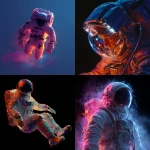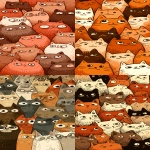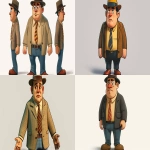Explore the Best AI Image Gallery

Beyond the Canvas: How Wearable Tech is Reshaping Creative Expression
The realm of creativity has always been a space of boundless imagination and innovation. From the earliest cave paintings to the intricate digital art of today, humans have consistently sought new ways to express themselves and engage with the world around them. Now, on the cusp of a technological revolution, wearable technology is poised to redefine the very nature of creative expression, blurring the lines between the physical and digital realms.
Wearable Tech: A New Creative Frontier
Wearable technology, encompassing devices such as smart glasses, augmented reality (AR) headsets, haptic feedback suits, and even bio-sensing jewelry, offers a wealth of possibilities for artists, designers, and creators of all disciplines. These innovative tools empower individuals to interact with their environment in unprecedented ways, transforming the creative process from conception to execution.
Applications in Art and Design
- Interactive Installations: Imagine stepping into an immersive art installation where your movements trigger dynamic light patterns, soundscapes, or even alterations to the physical structure. Wearable sensors can capture your actions and translate them into real-time artistic expressions, creating truly interactive and engaging experiences.
- Gesture-Based Art Creation: Free yourself from traditional tools like brushes and pencils. Wearables equipped with motion tracking technology allow artists to paint, sculpt, or even compose music using their body movements as the primary instrument of creation.
- Augmented Reality Design: Architects and designers can utilize AR glasses to visualize their creations in 3D within real-world environments. This allows for a more intuitive and collaborative design process, enabling clients to experience and provide feedback on designs before they are physically built.
Beyond Visual Arts
The impact of wearable tech extends far beyond the visual arts. Musicians can experiment with innovative instruments that respond to their bio-rhythms or use haptic feedback to create entirely new sonic textures. Writers can explore immersive worlds and characters through AR narratives, while dancers can choreograph routines that integrate seamlessly with real-time data captured by their wearables.
Ethical Considerations
As with any powerful technology, wearable tech in the creative industry raises important ethical considerations.
- Data Privacy and Security: Wearable devices collect a vast amount of personal data about users movements, emotions, and even physiological responses. It is crucial to ensure that this data is handled responsibly and ethically, with transparent consent mechanisms and robust security measures in place.
- Accessibility and Inclusion: Creative tools should be accessible to all individuals, regardless of their abilities or circumstances. Developers must strive to make wearable tech inclusive by considering the needs of diverse users and designing interfaces that are user-friendly and adaptable.
- Algorithmic Bias: AI algorithms used in creative applications can inherit biases from the data they are trained on, potentially leading to unfair or discriminatory outcomes. It is essential to actively mitigate bias in algorithmic design and ensure that creative tools promote equity and representation.
Future Trends
The convergence of wearable technology with other emerging fields, such as artificial intelligence (AI) and the metaverse, promises exciting new possibilities for creative expression.
- AI-Powered Creativity: Imagine collaborating with AI assistants that can generate artistic concepts, compose music, or even co-create immersive experiences with you.
- Metaverse Art and Performance: Wearables will play a crucial role in enabling users to inhabit and interact with virtual worlds, blurring the lines between physical and digital art forms. We can expect to see virtual galleries, interactive performances, and entirely new genres of creative expression emerging within these immersive spaces.
- Personalized Creativity: Wearable tech will increasingly cater to individual preferences and styles, allowing users to customize their creative tools and experiences. Imagine haptic feedback suits that adapt to your emotional state or AI assistants that learn your artistic preferences over time.
Conclusion
Wearable technology is ushering in a new era of creative expression, empowering individuals to break free from traditional constraints and explore uncharted territories. By embracing the possibilities while addressing the ethical challenges, we can harness the transformative power of wearables to unlock our collective creative potential and shape a future where art, technology, and human imagination converge in extraordinary ways.

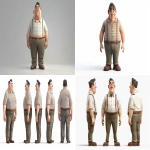
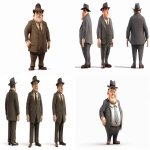

](https://images.ai-img.art/thumbnails/150/e07ad2e7379a835127482b0fd3176192c001c90e68a85b4315cf482b6a3f5ea5.webp)


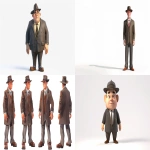

](https://images.ai-img.art/thumbnails/150/5487dcbcab0cd5702a67cc6819342ef56c05d0fc7730bfb7718ee291f10c3da3.webp)
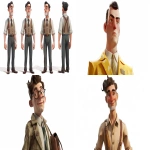
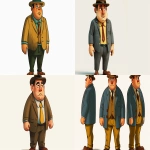
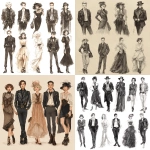
![**ultra detailed 8k cinematic black and white beauty portrait of a young woman from chest up, vertical frame, face, hands and hair filling the composition, smooth neutral grey studio background with soft dark vignette on the edges, center of the frame is her eye, lips and finger in a "shh" gesture oval symmetrical face with soft but well defined features, ultra smooth flawless skin, no pores, no wrinkles, perfect beauty retouch, straight elegant nose with soft highlight along the bridge and gentle shadow under the tip full sensuous lips with a sharp cupid’s bow, slightly parted, a thin bright glossy highlight strip on the lower lip emphasizing volume, subtle light reflection on the lip gloss one eye visible through a gap between fingers, other eye mostly hidden by the upper hand, long thick eyelashes like fake lashes, small bright catchlight in the pupil, upper eyelid with smoky eye makeup, darker tone along lash line fading smoothly towards the brow, dark thick well shaped eyebrows, gently arched, not overdramatic dark wavy hair, big glossy waves falling down, one clear S-shaped wave on the right side of the frame, soft highlights along the strands to show texture, hair swept away from the cheeks so the face is not covered both hands in thin semi-transparent black gloves up to the forearm, upper hand placed horizontally across the upper face, back of the hand towards camera, fingers slightly spread so that one finger is above the brows and another lower finger creates a narrow gap that reveals the eye, fingertips long and tapered, sharp stiletto-like nails visible under the sheer fabric, subtle darker seams along the fingers and glove edges lower hand bent so that the index finger is vertical and gently touching the center of the lips in a classic "shhh" pose, [...]** - Image #2 <@1264899319799222315>](https://images.ai-img.art/thumbnails/150/d87499f6bdc5a4a822aea4674654f70073b052542a1aaa1d08461a13ca2e07f9.webp)
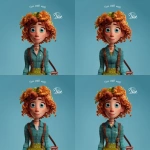
](https://images.ai-img.art/thumbnails/150/f3411154f4c743a26f102ecfc985f3f6214e93b285748fac66c88f3b52f85b26.webp)
![**ultra detailed 8k cinematic black and white beauty portrait of a young woman from chest up, vertical frame, face, hands and hair filling the composition, smooth neutral grey studio background with soft dark vignette on the edges, center of the frame is her eye, lips and finger in a "shh" gesture oval symmetrical face with soft but well defined features, ultra smooth flawless skin, no pores, no wrinkles, perfect beauty retouch, straight elegant nose with soft highlight along the bridge and gentle shadow under the tip full sensuous lips with a sharp cupid’s bow, slightly parted, a thin bright glossy highlight strip on the lower lip emphasizing volume, subtle light reflection on the lip gloss one eye visible through a gap between fingers, other eye mostly hidden by the upper hand, long thick eyelashes like fake lashes, small bright catchlight in the pupil, upper eyelid with smoky eye makeup, darker tone along lash line fading smoothly towards the brow, dark thick well shaped eyebrows, gently arched, not overdramatic dark wavy hair, big glossy waves falling down, one clear S-shaped wave on the right side of the frame, soft highlights along the strands to show texture, hair swept away from the cheeks so the face is not covered both hands in thin semi-transparent black gloves up to the forearm, upper hand placed horizontally across the upper face, back of the hand towards camera, fingers slightly spread so that one finger is above the brows and another lower finger creates a narrow gap that reveals the eye, fingertips long and tapered, sharp stiletto-like nails visible under the sheer fabric, subtle darker seams along the fingers and glove edges lower hand bent so that the index finger is vertical and gently touching the center of the lips in a classic "shhh" pose, [...]** - Image #4 <@1264899319799222315>](https://images.ai-img.art/thumbnails/150/8507c113aa12343ebd50af4ab9c637a6cf1acf21c55772271eb6a66bb04fa39c.webp)


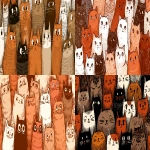

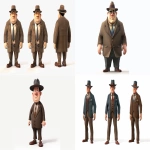



](https://images.ai-img.art/thumbnails/150/4f3d83c4b1d979b5be00f4ea80d67b71c0335bc1163e692d738e553ac37709e5.webp)



![**ultra detailed 8k cinematic black and white beauty portrait of a young woman from chest up, vertical frame, face, hands and hair filling the composition, smooth neutral grey studio background with soft dark vignette on the edges, center of the frame is her eye, lips and finger in a "shh" gesture oval symmetrical face with soft but well defined features, ultra smooth flawless skin, no pores, no wrinkles, perfect beauty retouch, straight elegant nose with soft highlight along the bridge and gentle shadow under the tip full sensuous lips with a sharp cupid’s bow, slightly parted, a thin bright glossy highlight strip on the lower lip emphasizing volume, subtle light reflection on the lip gloss one eye visible through a gap between fingers, other eye mostly hidden by the upper hand, long thick eyelashes like fake lashes, small bright catchlight in the pupil, upper eyelid with smoky eye makeup, darker tone along lash line fading smoothly towards the brow, dark thick well shaped eyebrows, gently arched, not overdramatic dark wavy hair, big glossy waves falling down, one clear S-shaped wave on the right side of the frame, soft highlights along the strands to show texture, hair swept away from the cheeks so the face is not covered both hands in thin semi-transparent black gloves up to the forearm, upper hand placed horizontally across the upper face, back of the hand towards camera, fingers slightly spread so that one finger is above the brows and another lower finger creates a narrow gap that reveals the eye, fingertips long and tapered, sharp stiletto-like nails visible under the sheer fabric, subtle darker seams along the fingers and glove edges lower hand bent so that the index finger is vertical and gently touching the center of the lips in a classic "shhh" pose, [...]** - Image #1 <@1264899319799222315>](https://images.ai-img.art/thumbnails/150/ff5a24c7c060f5350508823c406c28c9596aea4e37eefb60abc0f37504a37383.webp)
](https://images.ai-img.art/thumbnails/150/d08f607caf4a5c380defef68b778febb8911e8e51e51927b09ed67880bd3084b.webp)


](https://images.ai-img.art/thumbnails/150/7c4350a99935771fe343a7ae65c780cf4cd6b861e69cdc32bd58a3a92fb2476f.webp)
](https://images.ai-img.art/thumbnails/150/1871c145bfe0276c6e1bacf6ec0da6d2dae71370bf71674589af29a201acdd5f.webp)


![**ultra detailed 8k cinematic black and white beauty portrait of a young woman from chest up, vertical frame, face, hands and hair filling the composition, smooth neutral grey studio background with soft dark vignette on the edges, center of the frame is her eye, lips and finger in a "shh" gesture oval symmetrical face with soft but well defined features, ultra smooth flawless skin, no pores, no wrinkles, perfect beauty retouch, straight elegant nose with soft highlight along the bridge and gentle shadow under the tip full sensuous lips with a sharp cupid’s bow, slightly parted, a thin bright glossy highlight strip on the lower lip emphasizing volume, subtle light reflection on the lip gloss one eye visible through a gap between fingers, other eye mostly hidden by the upper hand, long thick eyelashes like fake lashes, small bright catchlight in the pupil, upper eyelid with smoky eye makeup, darker tone along lash line fading smoothly towards the brow, dark thick well shaped eyebrows, gently arched, not overdramatic dark wavy hair, big glossy waves falling down, one clear S-shaped wave on the right side of the frame, soft highlights along the strands to show texture, hair swept away from the cheeks so the face is not covered both hands in thin semi-transparent black gloves up to the forearm, upper hand placed horizontally across the upper face, back of the hand towards camera, fingers slightly spread so that one finger is above the brows and another lower finger creates a narrow gap that reveals the eye, fingertips long and tapered, sharp stiletto-like nails visible under the sheer fabric, subtle darker seams along the fingers and glove edges lower hand bent so that the index finger is vertical and gently touching the center of the lips in a classic "shhh" pose, [...]** - Image #3 <@1264899319799222315>](https://images.ai-img.art/thumbnails/150/4c03a422708b372b43caaee1e2929933c40f0a13dc069beeeb228a60b126223b.webp)


